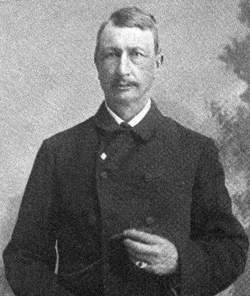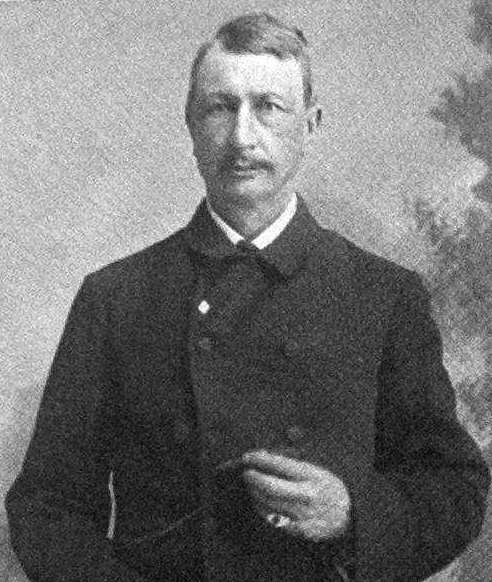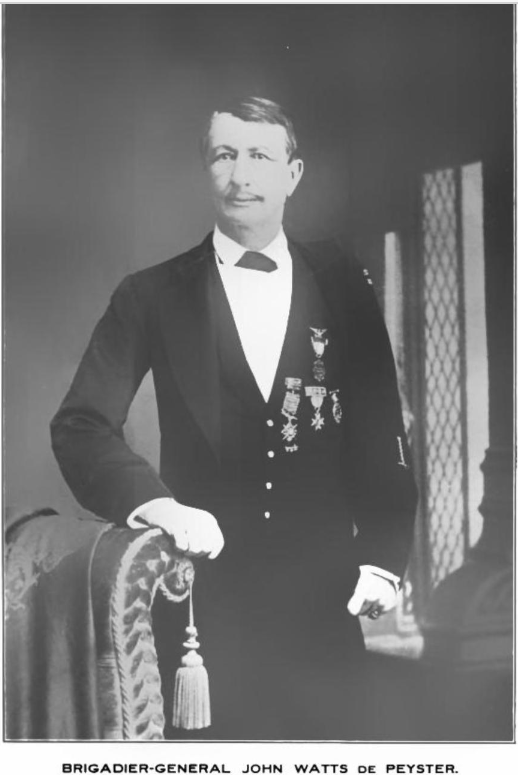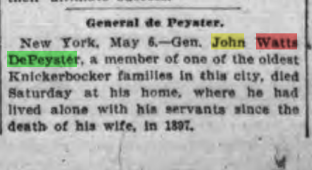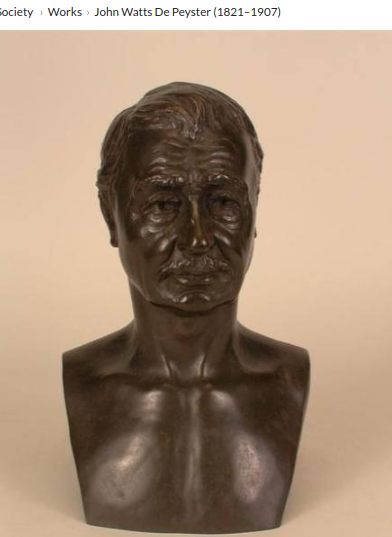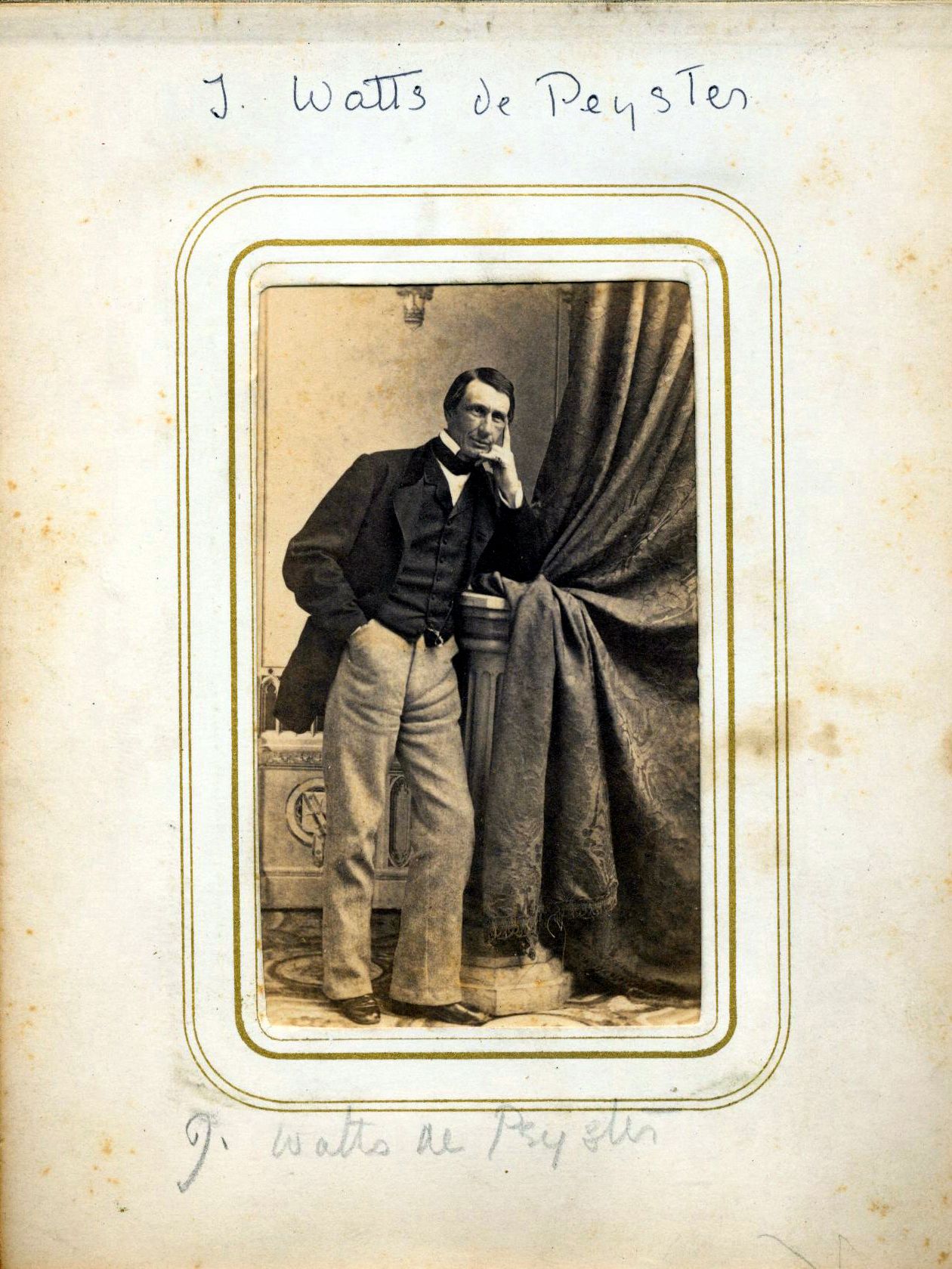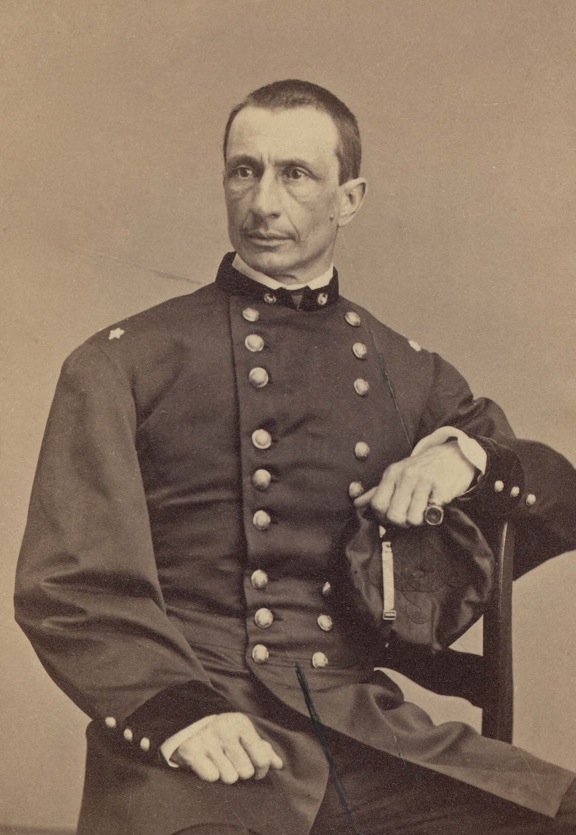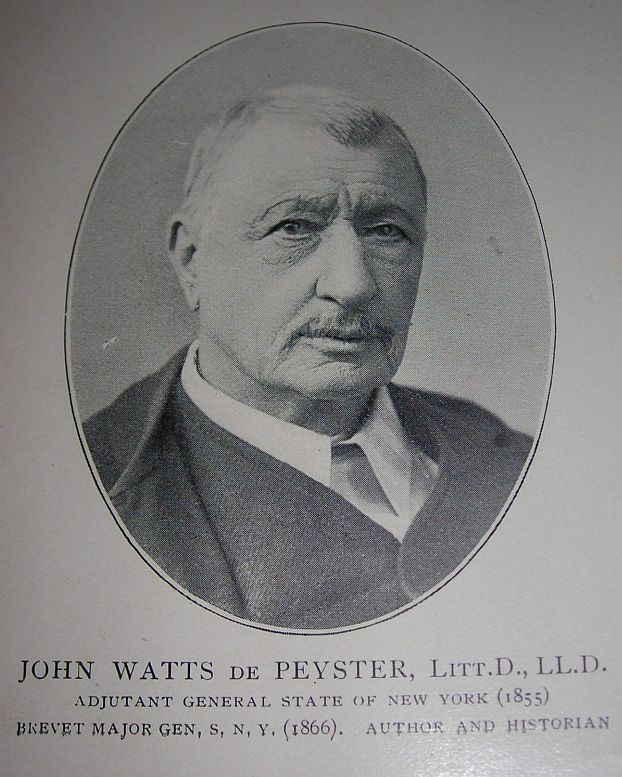In his later years he became a philanthropist, leaving his name on a number of buildings and institutions. He was born in New York City in 1821, and was the son of a wealthy and old Dutchess County family. His great great grandfather was Abraham de Peyster, an early mayor of New York City, and his great great great grandfather was also a mayor of New York City. His ancestors originally came from Flanders to the new world. Since Flanders at that time was part of the Netherlands, and since a name like de Peyster is clearly Dutch, it was considered appropriate to include John Watts de Peyster in the listing of prominent Dutch Americans.
De Peyster was well educated during his early years. He attended Columbia College, now Columbia University, as an undergraduate. But he apparently did not graduate because of health reasons. Later he did earn a M. A. degree from Columbia College, a LL. D. degree from Nebraska College, and a Ph. D. degree from Franklin and Marshall College. Although he did obtain a law degree, it is not clear if he ever practiced law. He, however, was engaged in many volunteer activities. He was one of the organizers of the New York City Police and Fire Departments, and was active as a volunteer fireman himself. He was also active in the New York State Militia, and was promoted to brigadier general in 1851. At the State level he also served as Judge Advocate General, and later Adjutant General, before he resigned over a conflict with New York Governor Myron Clark in 1855.
At the start of the Civil War, de Peyster was already in his forties. He did offer his services to the Union Army, but was rebuffed, probably for younger candidates. His three sons did serve in the Union Army during the war, and his name sake, John Watts de Peyster, Jr., actually rose to the level of brevet brigadier general.
During the Civil War, de Peyster (Sr.) wrote a series of articles on war tactics, and some of these tactics were adopted and proved to be practical in the field of battle. For his indirect contributions to the Civil War, the State of New York later elevated de Peyster to Brevet Major General.
Prior to and following the Civil War, de Peyster was a student of military history and authored books in the area. He published the following books listed below. "New American Tactics", a series of articles published in The Army and Navy Journal during the Civil War, "Life of Field Marshall Torstenson", published in 1855, "The Dutch at the North Pole", published in 1857, "Life of Baron Cohorn", published in 1858, "The Decisive Conflicts of the Late Civil War, or Slaveholder's Rebellion", published in 1867, "Personal and Military History of General Philip Kearney", published in 1869,
"The Life and Misfortunes and the Military Career of Brigadier General Sir John Johnson", published in 1882, and "Gypsies: Some Curious Investigations, Collected, Translated, or Reprinted from various Sources", published in 1887.
De Peyster was a developer and collector of real estate properties and valuable books. He willed most of the books and the real estate properties to institutions prior to his death. In 1901, he donated several thousand books and maps to the Smithsonian Institution. He also built, and then donated the first library building of his alma mater, to his alma mater, Franklin and Marshall College. He then also donated his rare collection of books on European history to the library. In 1905, de Peyster purchased the first baronial mansion of Sir William Johnson, known since 1755 as Fort Johnson, and donated it to the Montgomery County Historical Society, of Amsterdam, New York. And last but not least, he willed his Tivoli village mansion, named "Rose Hill", in New York City, to a local children's home.
De Peyster passed away on May 4, 1907. His life had been focused on making contributions to society, the community, history, and his country. To this day he is remembered by the various communities that benefited from his generosity during his lifetime."
*The New Netherland Institute, Albany, NY
Many of the de Peyster family are buried in the Trinity Churchyard in Block 1 and the
de Peyster vault. This includes Brevet Major General de Peyster's son of the same name who died in 1873.
Burial information from: Valentine's Manual of Old New York, 1922
∼Son of Mary Justina Watts (1801-1821) and Frederick De Peyster ESQ. (1796-1882).
He married Estelle Livingston (1819-1898) on March 2, 1841. There were 5 children from this union: John Watts De Peyster was born 2 December 1841 and died 12 April 1873), Colonel Frederick De Peyster , who was born 13 December 1842 and married Mary Livingston, Estelle Elizabeth De Peyster Toler, (James B Toler), who was born 1844 and died 12 December 1889, Colonel Johnston Livingston De Peyster, who was born 14 June 1846 and married Julia Anna Toler and Maria Livingston De Peyster (born7 July 1852 and died 24 September 1857).
John Watts De Peyster was an author on the art of war, philanthropist, and early Adjutant General of the New York National Guard. He served in the New York State Militia during the Mexican–American War and American Civil War. He was one of the first military critics and noted for his histories of the Revolutionary and Civil Wars, and also published works of drama, poetry, military history, military biography and military criticism. Please read this link to help understand his many credits:
http://en.wikipedia.org/wiki/John_Watts_de_Peyster
http://www.archive.org/stream/addressdelivered00depeys#page/n5/mode/2up
The second is an address that was given to the Townspeople in honor of the men from that Town who gave their lives in the Slave Holder's Rebellion in which the monument that stands in Tivoli today was dedicated.
On his personal life:
Poughkeepsie, Nov. 20-Gen. John Watts De Peyster, the millionaire philanthropist, is living the life of a recluse at Rose Hill, the ancestral seat of his family, at Tivoli. He is reputed to be worth millions, much of his property consisting of real estate in the city of New York, which has been in possession of his family over a century. He had isolated himself from his kindred and it is believed will give his fortune at his death to the institutions he has founded.
Years before the death of his wife, the general and Mrs. De Peyster lived apart and Col. Johnson L. De Peyster, the general's only son still living, lost his father's friendship by espousing his mother's cause. Father and son did not speak or hold any communication with each other, although their two estates adjoined. Gen. De Peyster was persistent in his estrangement from his son even up to the son's death. He did not visit him or inquire about him when he was ill. When Col. De Peyster died in May, two years ago, the grim old general closed the gates of Rose Hill.
A delegation of villagers who wished permission to drape De Peyster hall in memory of the colonel, who was very popular in Tivoli, was turned away without an audience. Gen. De Peyster refused to attend his son's funeral. His sole concession was to offer to the widow the keys of the family vault. The tender was ignored and Col. De Peyster's remains were laid at rest in the vault of Johnston Livingston, an uncle of the colonel's on his mother's side.
Boston Daily Globe Mon. Nov 20, 1908 p21
In his later years he became a philanthropist, leaving his name on a number of buildings and institutions. He was born in New York City in 1821, and was the son of a wealthy and old Dutchess County family. His great great grandfather was Abraham de Peyster, an early mayor of New York City, and his great great great grandfather was also a mayor of New York City. His ancestors originally came from Flanders to the new world. Since Flanders at that time was part of the Netherlands, and since a name like de Peyster is clearly Dutch, it was considered appropriate to include John Watts de Peyster in the listing of prominent Dutch Americans.
De Peyster was well educated during his early years. He attended Columbia College, now Columbia University, as an undergraduate. But he apparently did not graduate because of health reasons. Later he did earn a M. A. degree from Columbia College, a LL. D. degree from Nebraska College, and a Ph. D. degree from Franklin and Marshall College. Although he did obtain a law degree, it is not clear if he ever practiced law. He, however, was engaged in many volunteer activities. He was one of the organizers of the New York City Police and Fire Departments, and was active as a volunteer fireman himself. He was also active in the New York State Militia, and was promoted to brigadier general in 1851. At the State level he also served as Judge Advocate General, and later Adjutant General, before he resigned over a conflict with New York Governor Myron Clark in 1855.
At the start of the Civil War, de Peyster was already in his forties. He did offer his services to the Union Army, but was rebuffed, probably for younger candidates. His three sons did serve in the Union Army during the war, and his name sake, John Watts de Peyster, Jr., actually rose to the level of brevet brigadier general.
During the Civil War, de Peyster (Sr.) wrote a series of articles on war tactics, and some of these tactics were adopted and proved to be practical in the field of battle. For his indirect contributions to the Civil War, the State of New York later elevated de Peyster to Brevet Major General.
Prior to and following the Civil War, de Peyster was a student of military history and authored books in the area. He published the following books listed below. "New American Tactics", a series of articles published in The Army and Navy Journal during the Civil War, "Life of Field Marshall Torstenson", published in 1855, "The Dutch at the North Pole", published in 1857, "Life of Baron Cohorn", published in 1858, "The Decisive Conflicts of the Late Civil War, or Slaveholder's Rebellion", published in 1867, "Personal and Military History of General Philip Kearney", published in 1869,
"The Life and Misfortunes and the Military Career of Brigadier General Sir John Johnson", published in 1882, and "Gypsies: Some Curious Investigations, Collected, Translated, or Reprinted from various Sources", published in 1887.
De Peyster was a developer and collector of real estate properties and valuable books. He willed most of the books and the real estate properties to institutions prior to his death. In 1901, he donated several thousand books and maps to the Smithsonian Institution. He also built, and then donated the first library building of his alma mater, to his alma mater, Franklin and Marshall College. He then also donated his rare collection of books on European history to the library. In 1905, de Peyster purchased the first baronial mansion of Sir William Johnson, known since 1755 as Fort Johnson, and donated it to the Montgomery County Historical Society, of Amsterdam, New York. And last but not least, he willed his Tivoli village mansion, named "Rose Hill", in New York City, to a local children's home.
De Peyster passed away on May 4, 1907. His life had been focused on making contributions to society, the community, history, and his country. To this day he is remembered by the various communities that benefited from his generosity during his lifetime."
*The New Netherland Institute, Albany, NY
Many of the de Peyster family are buried in the Trinity Churchyard in Block 1 and the
de Peyster vault. This includes Brevet Major General de Peyster's son of the same name who died in 1873.
Burial information from: Valentine's Manual of Old New York, 1922
∼Son of Mary Justina Watts (1801-1821) and Frederick De Peyster ESQ. (1796-1882).
He married Estelle Livingston (1819-1898) on March 2, 1841. There were 5 children from this union: John Watts De Peyster was born 2 December 1841 and died 12 April 1873), Colonel Frederick De Peyster , who was born 13 December 1842 and married Mary Livingston, Estelle Elizabeth De Peyster Toler, (James B Toler), who was born 1844 and died 12 December 1889, Colonel Johnston Livingston De Peyster, who was born 14 June 1846 and married Julia Anna Toler and Maria Livingston De Peyster (born7 July 1852 and died 24 September 1857).
John Watts De Peyster was an author on the art of war, philanthropist, and early Adjutant General of the New York National Guard. He served in the New York State Militia during the Mexican–American War and American Civil War. He was one of the first military critics and noted for his histories of the Revolutionary and Civil Wars, and also published works of drama, poetry, military history, military biography and military criticism. Please read this link to help understand his many credits:
http://en.wikipedia.org/wiki/John_Watts_de_Peyster
http://www.archive.org/stream/addressdelivered00depeys#page/n5/mode/2up
The second is an address that was given to the Townspeople in honor of the men from that Town who gave their lives in the Slave Holder's Rebellion in which the monument that stands in Tivoli today was dedicated.
On his personal life:
Poughkeepsie, Nov. 20-Gen. John Watts De Peyster, the millionaire philanthropist, is living the life of a recluse at Rose Hill, the ancestral seat of his family, at Tivoli. He is reputed to be worth millions, much of his property consisting of real estate in the city of New York, which has been in possession of his family over a century. He had isolated himself from his kindred and it is believed will give his fortune at his death to the institutions he has founded.
Years before the death of his wife, the general and Mrs. De Peyster lived apart and Col. Johnson L. De Peyster, the general's only son still living, lost his father's friendship by espousing his mother's cause. Father and son did not speak or hold any communication with each other, although their two estates adjoined. Gen. De Peyster was persistent in his estrangement from his son even up to the son's death. He did not visit him or inquire about him when he was ill. When Col. De Peyster died in May, two years ago, the grim old general closed the gates of Rose Hill.
A delegation of villagers who wished permission to drape De Peyster hall in memory of the colonel, who was very popular in Tivoli, was turned away without an audience. Gen. De Peyster refused to attend his son's funeral. His sole concession was to offer to the widow the keys of the family vault. The tender was ignored and Col. De Peyster's remains were laid at rest in the vault of Johnston Livingston, an uncle of the colonel's on his mother's side.
Boston Daily Globe Mon. Nov 20, 1908 p21
Family Members
Sponsored by Ancestry
Advertisement
Explore more
Sponsored by Ancestry
Advertisement
